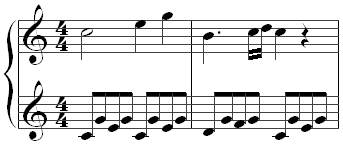Alberti bass
The Alberti bass (mostly used in the plural : Alberti basses, also Albertian basses or harp basses ) is a special type of musical accompaniment that is mainly used in classical music . The Alberti bass is named after its inventor Domenico Alberti .
It is a written out arpeggio in which the individual notes of the chords do not sound simultaneously, but one after the other, usually in the order “lowest, highest, middle, highest tone”. The order is not fixed, however, so the composer can vary it as desired. This pattern is then repeated several times. A well-known example of an Alberti bass is the beginning of Wolfgang Amadeus Mozart's Piano Sonata in C major , KV 545:
As a rule, the Alberti basses are used as accompanying figures in works for keyboard instruments and then played with the left hand, more rarely with the right hand, but they can also be found in compositions for other instruments, such as B. in Béla Bartók's 5th String Quartet from 1934 . Typical positions are the "small" and the "dashed" octave.
Individual evidence
- ^ Heinrich Christoph Koch : Musical Lexicon . Frankfurt 1802, column 128.
- ↑ Michael Mailer: Glossary: Music ( Albertische Basses ). In: desig-n.de , accessed on November 26, 2016
